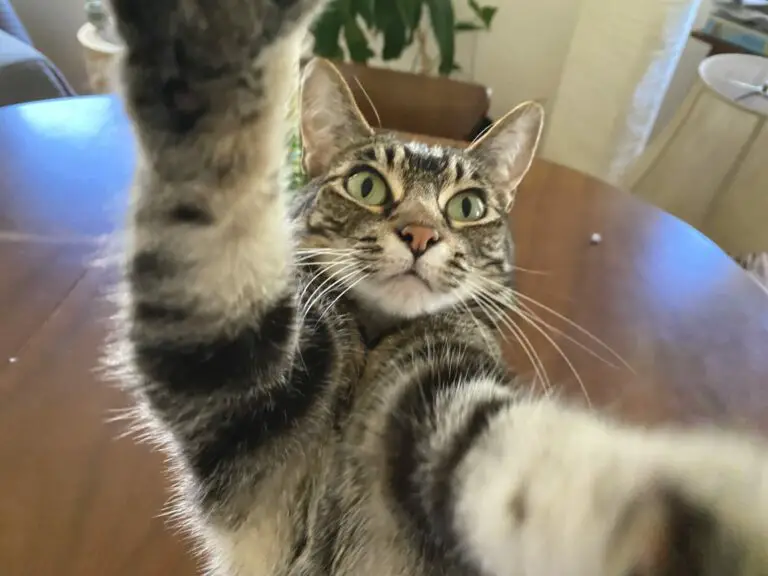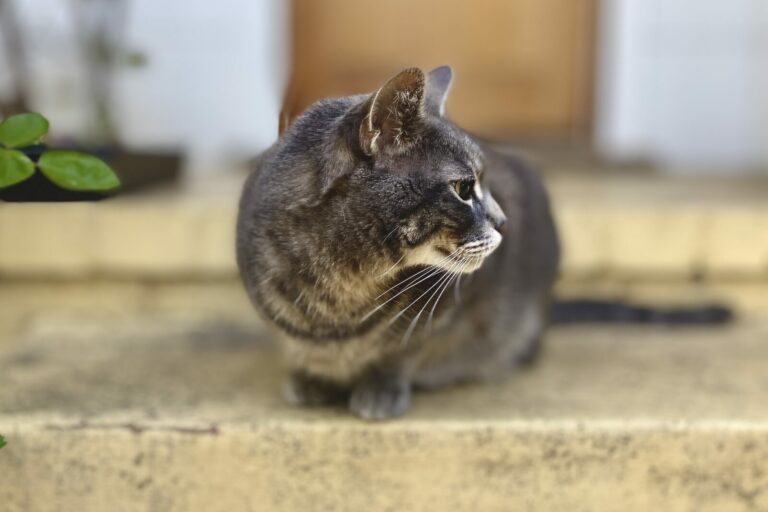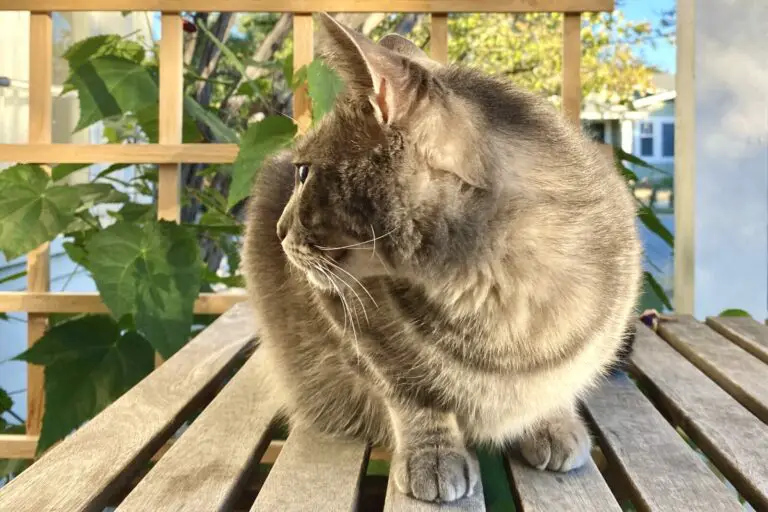Optimize Health by Simulating Hunting for Your Indoor Cat
How do you meet your cats’ basic hunting instincts when you want to keep her inside and protect her from the high risks of free roaming outdoors?
There’s actually a lot you can do here for your indoor cat, and it matters for her health and happiness. It’s something I take very seriously for my own three strictly-indoor fuzz butts.
This article is part of the VerveCat series on the indoor vs outdoor cat debate.

Here, we cover everything you need to know about building the hunt into your cat’s daily life, including a list of tips for making the most of playtime with your cat.
The Natural Predatory Instincts of Cats
Despite their often cushy lives as indoor pets, domestic cats retain the sharp instincts of their wild ancestors. Your cat is wired to stalk, pounce, and play in ways that mimic the hunt.
These instincts are not just whimsical traits; they are the essence of catness and a part of their basic needs. Therefore, they shouldn’t be ignored just because the cat doesn’t go outside.
A cat that “hunts” every day is a mentally stimulated, physically active cat.
On the flip side, without an outlet for predatory instincts, cats can develop a range of issues, from obesity to behavioral problems stemming from boredom, such as aggression or destructive tendencies.
Good news is, there are many ways to bring out the inner hunter in your house cat.
Interactive toys that dart and dive, puzzle feeders that challenge and reward, and play sessions that mimic the thrill of the chase – all can transform your living room into a jungle and your cat into the majestic predator she was born to be.
Below, we’ll explore a variety of ways you can engage and stimulate your cat’s hunting instincts and provide a full and healthy indoor life.
First, let’s talk about why it’s so important for your cat.
The Role of Hunting in a Cat’s Physical and Mental Health
Cats’ instinctual predatory behavior plays a huge role in a cat’s overall health because it’s both physically and cognitively demanding.
However, the lifestyle of an indoor cat can inadvertently stifle these natural behaviors. As cat guardians, we have to provide an environment that meets these basic needs. Otherwise, boredom, stress, and a host of associated health issues can result.
Yes, indoor cats are safe from the dangers of the outside world and will probably have longer lives because of it. But they still require opportunities to be predators.
If you’ve paid close attention to your cat, you’ve probably noticed a sequence of behaviors that form the hunting cycle: stalking, crouching, pouncing, attacking, and eating.
In the following sections, we’ll delve into practical ways you can simulate that cycle within your own home.
Interactive Playtime
Interactive playtime is a critical piece of indoor cat enrichment. Toys and games tap into your feline’s hunting sequence. They also provide a ton of fun and entertainment for you and your furry pal.
There’s a wide variety of toys available that are designed to mimic the movements of prey.
For example, the dangle and twitch of a wand toy mimic the erratic movements of insects and birds. Motorized (or thrown) mice that scurry unpredictably tap into the chase. And dragging a toy around the corner into another room mimics a small animal attempting to escape or hide.
Each type of toy appeals to different aspects of your cat’s hunting instincts with a sense of unpredictability and novelty. You’ll probably end up inventing games with your cat, based on favorite toys and movements.
My favorite thing is probably throwing a piece of rope for Phoebe. She loves watching it disappear over furniture before she leaps over, picks it up in her mouth, and comes bounding back to me to drop it at my feet. Or at least somewhere near my feet – she definitely has room for perfecting the return!
Playtime Tips You Can Use to Simulate Hunting Conditions
Play with your cat every day. It should be lively and varied. Here are some tips for options you can work into your routine:
Mimic real prey unpredictability
- Vary movements of toys. Drag quickly, hide, or use quick stops and starts, like prey in the wild.
- Incorporate different speeds, erratic movements, and quick direction changes to games.
- Vary the difficulty level for your cat by quickly pulling toys just out of reach or briefly hiding them to prolong stalking.
- Drag toys over and behind objects and furniture.
- Use wand toys or feather teasers to mimic prey for chasing and pouncing.
- Allow your cat to stalk and pounce.
Keep things fresh and interesting
- Rotate toys to refresh novelty and prevent habituation. Introduce new items periodically.
- Experiment with different toys and games. You never know what will end up being your cat’s favorites.
- Use food dispensing toys that make cats “work” to earn kibble.
- Many play techniques require skill on your part. You can take it as a challenge. The better you get, the more engaging and beneficial it is for your cat.
Use your entire cat-friendly indoor environment
- Provide both ground level and elevated play spaces to accommodate different hunting techniques.
- Hide toys around the home and make your cat search and seek to find them.
- Play the same games in different rooms.
- Opt for interactive toys over lazier options to get cats more actively engaged.
Use strategic timing for play
- Playtime just before meals can tap into your cat’s peak natural hunting drive.
- Allow your cat to periodically “catch” the toy and offer praise. Lets them feel the satisfaction of a successful capture
- Finish sessions by allowing the cat to swat, kick, or “kill” the toy.
- Consider ending play sessions with a treat or a meal, satisfying the ‘eat’ portion of their natural hunting cycle.
Special Considerations for Playtime in the Multi-Cat Household
Figure out what each cat really loves. It can vary quite a bit between cats. And try to dedicate time for each cat. In homes with more than one cat, this can be tricky because there is usually a cat that is lowest in the pecking order.
For a cat that may not assert itself as the “alpha”, try closing off the other cats in a separate room so you can dedicate some one-on-one play time. Shy or timid cats can feel intimidated trying to participate in playtime alongside more dominant housemates.
In my house, if it’s a free-for-all, poor Bean is always the one left watching on the sidelines as Phoebe and Gandalf hog my attention.
Feeding Strategies that Encourage Hunting Behavior
Hiding Food or Treats Around the House as a Game
Another way to encourage your cat’s hunting instincts is to hide small portions of food around your home. This stimulates their natural desire to search for prey and encourages physical activity.
Start with easy-to-find spots and gradually increase the difficulty as your cat becomes more adept at the game. It’s a fun way to turn the entire house into a hunting ground.
Puzzle Feeders and Food Dispenser Toys
Using feeding strategies that mimic the hunt can make for stimulating games for your indoor cat. Puzzle feeders and food-dispensing toys can be a great way to provide a mental challenge as your cat works to release kibble or treats.
These devices can range from simple balls that release food when batted around, to more complex puzzles that require problem-solving skills.
Distinct Feeding Times vs. Grazing
Last, consider using a feeding schedule. In the wild, cats hunt multiple times a day, and their meals are not always guaranteed. A free-grazing (always food available) setup works against this natural rhythm, and can make overeating and obesity more likely.
On the other hand, distinct meal times each day more closely replicate the routine of intermittent hunting.
Optimizing the Cat Friendliness of Your Home
By designing your home with your cat’s needs in mind, you can create a dynamic space that encourages natural behaviors like climbing, hiding, and scratching. Here, we’re talking about the layout and accessibility of the space your cat lives in.
Vertical Space
Cats love heights, which in the wild, offer safety and a vantage point to spot prey or predators from.
Tall cat trees, wall-mounted shelves, and even bookcases can serve as perfect perches for your cat. These elevated spots satisfy the instinct to climb and oversee their territory, providing both a sense of security and some built-in exercise.
In one house I lived in, we set up the tops of the fridge and stacked laundry machines with cat beds. It gave our cats a secure spot to sleep high off the ground, and included a view out the window as a bonus.
If you do use spaces like this, just make sure there’s a way for your cat to get up there (and be up there) safely. For example, you don’t want a cat bed to slide off or a shelf to tip over.
Hiding Spots
In addition to vertical spaces, hiding spots are essential for a cat’s sense of safety and for those moments when they want to retreat to a quiet place. Cardboard boxes, tunnel toys, or even cat-specific furniture with built-in hideaways can serve this purpose.
You can also work these spaces into play. From hiding spots, your cat can “stalk” you or toys, preparing for the surprise pounce.
Use of Windows
Cats love a good window perch, both for lazy sun lounging, and for scanning for and tracking potential prey. This is stimulating and engaging for your cat even if she can’t actually chase after what she sees.
Just be absolutely sure the window screen is secure and can’t be pushed out before you open the window for your cat. Last time I moved to a new house, I made the mistake of not checking how secure a window screen was and two of my cats got out without me even knowing at first. Yikes.
DIY and Homemade Toy Ideas
Some DIY and homemade toys can be just as effective at satisfying a cat’s hunting instincts as expensive store-bought stuff.
I’m always on the lookout for budget-friendly options, and there are so many simple, creative cat toys you can make yourself with what you already have lying around the house. Even things that you’d typically recycle or throw away can make good toys.
Some DIY cat toy examples
Here are a few examples to give you an idea, but be sure to check out the linked article above for a comprehensive list of ideas and descriptions.
- Old sock tied with catnip
- Toilet paper or paper towel tube tumbler
- Aluminum foil ball
- Stick and string wand toy
- Cardboard tube puzzle feeders
- Plastic bottle cap
- Paper bag (remove handles) endless stalk and pounce game
Safe Options for Providing a Taste of the Outdoors
A. Safe ways to expose indoor cats to the outdoors B. Building or purchasing a ‘catio’ for controlled outdoor access C. Harness and leash training for supervised exploration
Outdoor enclosures and leash training can provide the best of both worlds: the stimulation of the outdoors and the safety of a controlled environment.
Outdoor enclosures, known as ‘catios,’ can be a wonderful addition to your home. These range from screened boxes that extend out from a window, to large freestanding units that can be placed anywhere outside your house. Some favorites I’ve seen are ones where people have converted a deck or screened porch into a catio.
Obviously, these offer the benefits of engaging most of the senses involved in free roaming outside. Fresh air, sunshine, and the sights and sounds of nature. Cats interpret much of the world around them with their noses, and a catio can serve up a lot more scents than just an open window.
But a catio is either a lot of work or a lot of money, and you have to have a space that works. This just isn’t possible for many people. If this is you, then you might want to consider a simple window ledge or window box – some way of optimizing your windows for your cat.
Or you can train your cat to use a harness and leash outdoors. This allows for supervised exploration while giving your cat a taste of freedom. This will take work and patience on your part – gradual introduction, patience, and positive reinforcement are key to success.
Any of the above options give your cat some access to the outdoors, without taking the huge risks that come with uncontrolled free-roaming.
Last Meows
When you give your cat opportunities to engage in predatory behaviors like stalking, pouncing, and capturing, she will not only be physically fitter but also mentally sharper and more content. As an added bonus, you’ll probably be minimizing behavioral issues, too.

